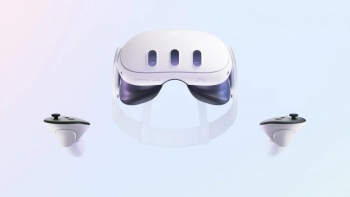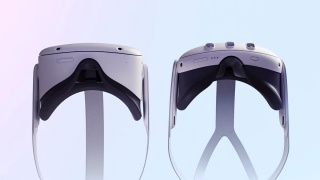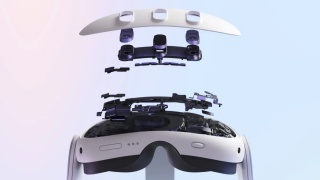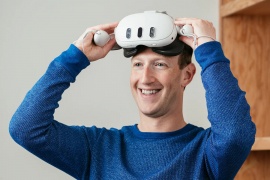Meta Quest 3: Difference between revisions
Xinreality (talk | contribs) No edit summary |
Xinreality (talk | contribs) m Text replacement - "|VR/AR = VR" to "|VR/AR = Virtual Reality" |
||
| (19 intermediate revisions by 3 users not shown) | |||
| Line 1: | Line 1: | ||
{{Device Infobox | {{Device Infobox | ||
|image = | |image = [[file:meta quest 31.jpg|350px]] | ||
|VR/AR = [[ | |VR/AR = [[Virtual Reality]] | ||
|Type = [[head-mounted display]] | |Type = [[head-mounted display]] | ||
|Subtype = [[Standalone VR]] | |Subtype = [[Standalone VR]] | ||
| Line 7: | Line 7: | ||
|Creator = | |Creator = | ||
|Developer = | |Developer = | ||
|Manufacturer = [[Meta]] | |Manufacturer = [[Meta Platforms]] | ||
|Announcement Date = June 1, 2023 | |Announcement Date = June 1, 2023 | ||
|Release Date = October 10, 2023 | |Release Date = October 10, 2023 | ||
|Price = $499 | |Price = $499 | ||
|Website = meta.com | |Website = meta.com | ||
|Versions = | |Versions = | ||
|Requires = | |Requires = | ||
|Predecessor = | |Predecessor = [[Meta Quest 2]] | ||
|Successor = | |Successor = [[Meta Quest 4]] | ||
|Operating System = [[Android]] | |Operating System = [[Android]] | ||
|Chipset = [[Qualcomm Snapdragon XR2 Gen 2]] | |Chipset = [[Qualcomm Snapdragon XR2 Gen 2]] | ||
| Line 27: | Line 27: | ||
|Subpixel Layout = [[RGB stripe]] | |Subpixel Layout = [[RGB stripe]] | ||
|Peak Brightness = | |Peak Brightness = | ||
|Resolution = 2064x2208 | |Resolution = 2064x2208 per-eye | ||
|Refresh Rate = 120 Hz | |Refresh Rate = 120 Hz | ||
|Pixel Density = | |Pixel Density = 1218 PPI per eye | ||
|Persistence = | |Persistence = | ||
|Precision = | |Precision = | ||
|Field of View = | |Field of View = | ||
|Horizontal FoV = 110° | |Horizontal FoV = 110° | ||
|Vertical FoV = 96° | |Vertical FoV = | ||
|Visible FoV = 110° (horizontal), 96° (vertical) | |||
|Rendered FoV = | |Rendered FoV = | ||
|Binocular Overlap = | |Binocular Overlap = | ||
| Line 71: | Line 71: | ||
|Power = | |Power = | ||
|Battery Capacity = | |Battery Capacity = | ||
|Battery Life = | |Battery Life = 2.2 hours | ||
|Charge Time = 2.3 hours | |Charge Time = 2.3 hours | ||
|Dimensions = | |Dimensions = | ||
|Weight = | |Weight = 515g (with headstrap) | ||
|Material = Plastic, foam facial interface | |Material = Plastic, foam facial interface | ||
|Headstrap = Flexible fabric strap | |Headstrap = Flexible fabric strap | ||
|Haptics = | |Haptics = No | ||
|Color = White | |Color = White | ||
|Sensors = | |Sensors = | ||
|Input = | |Input = 2 x Meta Quest Touch Plus Controllers | ||
|Compliance = | |Compliance = | ||
|Size = | |Size = | ||
| Line 86: | Line 86: | ||
}} | }} | ||
[[Meta Quest 3]] is a [[virtual reality headset]] developed and manufactured by [[Meta Platforms]]. It was released in October 2023, following its announcement in June 2023. It is a successor to the [[Meta Quest 2]]. | |||
__TOC__ | __TOC__ | ||
== Specifications == | |||
=== Display and Optics === | |||
* '''[[Resolution]]:''' Each eye of the [[Meta Quest 3]] is treated to a resolution of 2064x2208, amounting to a total of approximately 9.11 million pixels. | |||
* '''[[Field of View]]:''' The headset provides an estimated 110° horizontal and 96° vertical field of view. | |||
* '''[[Refresh Rate]]:''' A high refresh rate of 120 Hz enhances the smoothness of visual experiences. | |||
* '''[[Optics]]:''' Utilizing [[pancake lenses]], the Meta Quest 3 offers improved visual clarity and user comfort. | |||
=== Build and Design === | |||
* '''[[Weight]]:''' The headset weighs 515 grams, including the [[headstrap]]. | |||
* '''[[Materials]]:''' Constructed with [[plastic]] and a [[foam facial interface]], the design focuses on user comfort. | |||
* '''[[Headstrap]]:''' A flexible [[fabric strap]] is included for secure and comfortable fitting. | |||
=== Performance and Hardware === | |||
* '''[[Chipset]]:''' Powered by the [[Qualcomm Snapdragon XR2 Gen 2]], the Meta Quest 3 offers robust performance. | |||
* '''Memory and Storage:''' It comes with 8 GB of memory and options for 128 GB or 512 GB of storage. | |||
* '''Battery Life:''' The device offers up to 2.2 hours of battery life with a charge time of 2.3 hours. | |||
* '''[[Tracking]]:''' [[6DoF inside-out tracking]] is enabled via four integrated [[cameras]], alongside [[hand tracking capabilities]]. | |||
=== Controllers === | |||
* '''[[Meta Quest Touch Plus Controllers]]:''' Two [[6DoF controllers]] are included, featuring [[capacitive buttons]], [[joysticks]], and [[touchpads]] for immersive interaction. | |||
== Overview == | == Overview == | ||
Quest 3 presents itself as a next-generation VR headset, particularly in terms of hardware. Priced at $500, it is a substantial improvement over its predecessor, Quest 2, which was priced at $300. The Quest 3 boasts impressive hardware, comparable to a cheaper version of the Quest Pro, albeit without eye-tracking and face-tracking features. Despite these omissions, Quest 3 remains a favorable choice even if priced similarly to the Quest Pro. | [[Quest 3]] presents itself as a next-generation [[VR headset]], particularly in terms of hardware. Priced at $500, it is a substantial improvement over its predecessor, [[Quest 2]], which was priced at $300. The Quest 3 boasts impressive hardware, comparable to a cheaper version of the [[Quest Pro]], albeit without [[eye-tracking]] and [[face-tracking]] features. Despite these omissions, Quest 3 remains a favorable choice even if priced similarly to the Quest Pro. | ||
=== Key Improvements in Hardware === | === Key Improvements in Hardware === | ||
The Quest 3 showcases several advancements in its hardware: | The Quest 3 showcases several advancements in its hardware: | ||
* '''Lenses:''' A significant improvement over the Quest 2, offering wider field-of-view and reduced glare. | * '''[[Lenses]]:''' A significant improvement over the Quest 2, offering wider [[field-of-view]] and reduced glare. | ||
* '''Resolution and Clarity:''' Though not massively higher than Quest 2, the Quest 3 provides improved clarity and a reduction in screen-door effect. | * '''[[Resolution]] and [[Clarity]]:''' Though not massively higher than Quest 2, the Quest 3 provides improved clarity and a reduction in screen-door effect. | ||
* '''Ergonomics:''' Despite minimal ergonomic advancements, the adaptability of the headset for individual users is enhanced. | * '''[[Ergonomics]]:''' Despite minimal ergonomic advancements, the adaptability of the headset for individual users is enhanced. | ||
* '''Field-of-View:''' Improved eye-relief settings contribute to a wider field-of-view. | * '''[[Field-of-View]]:''' Improved eye-relief settings contribute to a wider field-of-view. | ||
* '''Audio:''' The built-in audio quality and volume have been notably improved. | * '''[[Audio]]:''' The built-in audio quality and volume have been notably improved. | ||
=== Controllers and Processor === | === Controllers and Processor === | ||
* '''Controllers:''' The new Touch Plus controllers offer better haptics and an improved form-factor. | * '''[[Controllers]]:''' The new [[Touch Plus controllers]] offer better haptics and an improved form-factor. | ||
* '''Processor:''' The Snapdragon XR2 Gen 2 chip provides a significant leap in graphical horsepower, with 2.6x the capability of its predecessor and 33% more CPU power. | * '''[[Processor]]:''' The [[Snapdragon XR2 Gen 2 chip]] provides a significant leap in graphical horsepower, with 2.6x the capability of its predecessor and 33% more CPU power. | ||
== Software Potential == | == Software Potential == | ||
While the hardware of Quest 3 is commendable, its software is yet to fully leverage the headset's capabilities. The transition for developers from targeting Quest | While the hardware of Quest 3 is commendable, its software is yet to fully leverage the headset's capabilities. The transition for developers from targeting [[Quest 2]]’s hardware to optimizing for Quest 3 will take time. The launch of the headset did not coincide with a substantial amount of content specifically enhanced for Quest 3, leading to a gap in experiencing the full potential of the hardware. | ||
=== Passthrough and Mixed Reality === | === [[Passthrough]] and [[Mixed Reality]] === | ||
Quest 3's passthrough view has improved but still faces limitations, particularly in terms of motion blur and depth cues. The lack of occlusion support further detracts from the immersive experience. The mixed reality capabilities, though still in early stages, show promise with features like room scanning and the ability to suggest playspace boundaries. | Quest 3's passthrough view has improved but still faces limitations, particularly in terms of motion blur and depth cues. The lack of occlusion support further detracts from the immersive experience. The mixed reality capabilities, though still in early stages, show promise with features like room scanning and the ability to suggest playspace boundaries. | ||
== Market Position and Recommendation == | == Market Position and Recommendation == | ||
Despite its shortcomings at launch, the Quest 3 stands out as the best standalone headset currently available. Its potential for growth and improvement, similar to the enhancements seen in Quest 2 over its lifetime, makes it a recommendable option over its predecessor. The Quest 3 is expected to significantly evolve in terms of software and mixed reality experiences within a year of its release. | Despite its shortcomings at launch, the Quest 3 stands out as the best standalone headset currently available. Its potential for growth and improvement, similar to the enhancements seen in Quest 2 over its lifetime, makes it a recommendable option over its predecessor. The Quest 3 is expected to significantly evolve in terms of software and mixed reality experiences within a year of its release. | ||
==Images== | ==Images== | ||
| Line 127: | Line 143: | ||
</gallery> | </gallery> | ||
[[Category:Virtual Reality]] | [[Category:Virtual Reality Devices]] | ||
Latest revision as of 20:03, 5 May 2025
| Meta Quest 3 | |
|---|---|

| |
| Basic Info | |
| VR/AR | Virtual Reality |
| Type | head-mounted display |
| Subtype | Standalone VR |
| Platform | Meta Quest |
| Manufacturer | Meta Platforms |
| Announcement Date | June 1, 2023 |
| Release Date | October 10, 2023 |
| Price | $499 |
| Website | meta.com |
| Predecessor | Meta Quest 2 |
| Successor | Meta Quest 4 |
| System | |
| Operating System | Android |
| Chipset | Qualcomm Snapdragon XR2 Gen 2 |
| CPU | Octa-core Kryo (1 x 3.19 GHz, 4 x 2.8 GHz, 3 x 2.0 GHz) |
| GPU | Adreno 740 |
| Storage | |
| Storage | 128 GB |
| Memory | 8 GB |
| SD Card Slot | No |
| Display | |
| Display | 2 x LCD |
| Subpixel Layout | RGB stripe |
| Resolution | 2064x2208 per-eye |
| Pixel Density | 1218 PPI per eye |
| Refresh Rate | 120 Hz |
| Image | |
| Horizontal FoV | 110° |
| Visible FoV | 110° (horizontal), 96° (vertical) |
| Peak Pixel Density | 25 PPD |
| Optics | |
| Optics | Pancake lenses |
| Ocularity | Binocular |
| IPD Range | 58-71 mm |
| Passthrough | Dual 18 PPD color passthrough cameras |
| Tracking | |
| Tracking | 6 DoF Inside-out via 4 integrated cameras |
| Base Stations | No |
| Eye Tracking | No |
| Face Tracking | No |
| Hand Tracking | Yes |
| Body Tracking | No |
| Audio | |
| Audio | Integrated stereo speakers |
| Microphone | Yes |
| 3.5mm Audio Jack | Yes |
| Connectivity | |
| Ports | USB Type-C, charging contacts |
| Wired Video | USB Type-C |
| Wireless Video | WiFi streaming |
| WiFi | WiFi 6E |
| Bluetooth | Bluetooth |
| Battery Life | 2.2 hours |
| Charge Time | 2.3 hours |
| Device | |
| Weight | 515g (with headstrap) |
| Material | Plastic, foam facial interface |
| Headstrap | Flexible fabric strap |
| Haptics | No |
| Color | White |
| Input | 2 x Meta Quest Touch Plus Controllers |
Meta Quest 3 is a virtual reality headset developed and manufactured by Meta Platforms. It was released in October 2023, following its announcement in June 2023. It is a successor to the Meta Quest 2.
Specifications
Display and Optics
- Resolution: Each eye of the Meta Quest 3 is treated to a resolution of 2064x2208, amounting to a total of approximately 9.11 million pixels.
- Field of View: The headset provides an estimated 110° horizontal and 96° vertical field of view.
- Refresh Rate: A high refresh rate of 120 Hz enhances the smoothness of visual experiences.
- Optics: Utilizing pancake lenses, the Meta Quest 3 offers improved visual clarity and user comfort.
Build and Design
- Weight: The headset weighs 515 grams, including the headstrap.
- Materials: Constructed with plastic and a foam facial interface, the design focuses on user comfort.
- Headstrap: A flexible fabric strap is included for secure and comfortable fitting.
Performance and Hardware
- Chipset: Powered by the Qualcomm Snapdragon XR2 Gen 2, the Meta Quest 3 offers robust performance.
- Memory and Storage: It comes with 8 GB of memory and options for 128 GB or 512 GB of storage.
- Battery Life: The device offers up to 2.2 hours of battery life with a charge time of 2.3 hours.
- Tracking: 6DoF inside-out tracking is enabled via four integrated cameras, alongside hand tracking capabilities.
Controllers
- Meta Quest Touch Plus Controllers: Two 6DoF controllers are included, featuring capacitive buttons, joysticks, and touchpads for immersive interaction.
Overview
Quest 3 presents itself as a next-generation VR headset, particularly in terms of hardware. Priced at $500, it is a substantial improvement over its predecessor, Quest 2, which was priced at $300. The Quest 3 boasts impressive hardware, comparable to a cheaper version of the Quest Pro, albeit without eye-tracking and face-tracking features. Despite these omissions, Quest 3 remains a favorable choice even if priced similarly to the Quest Pro.
Key Improvements in Hardware
The Quest 3 showcases several advancements in its hardware:
- Lenses: A significant improvement over the Quest 2, offering wider field-of-view and reduced glare.
- Resolution and Clarity: Though not massively higher than Quest 2, the Quest 3 provides improved clarity and a reduction in screen-door effect.
- Ergonomics: Despite minimal ergonomic advancements, the adaptability of the headset for individual users is enhanced.
- Field-of-View: Improved eye-relief settings contribute to a wider field-of-view.
- Audio: The built-in audio quality and volume have been notably improved.
Controllers and Processor
- Controllers: The new Touch Plus controllers offer better haptics and an improved form-factor.
- Processor: The Snapdragon XR2 Gen 2 chip provides a significant leap in graphical horsepower, with 2.6x the capability of its predecessor and 33% more CPU power.
Software Potential
While the hardware of Quest 3 is commendable, its software is yet to fully leverage the headset's capabilities. The transition for developers from targeting Quest 2’s hardware to optimizing for Quest 3 will take time. The launch of the headset did not coincide with a substantial amount of content specifically enhanced for Quest 3, leading to a gap in experiencing the full potential of the hardware.
Passthrough and Mixed Reality
Quest 3's passthrough view has improved but still faces limitations, particularly in terms of motion blur and depth cues. The lack of occlusion support further detracts from the immersive experience. The mixed reality capabilities, though still in early stages, show promise with features like room scanning and the ability to suggest playspace boundaries.
Market Position and Recommendation
Despite its shortcomings at launch, the Quest 3 stands out as the best standalone headset currently available. Its potential for growth and improvement, similar to the enhancements seen in Quest 2 over its lifetime, makes it a recommendable option over its predecessor. The Quest 3 is expected to significantly evolve in terms of software and mixed reality experiences within a year of its release.





